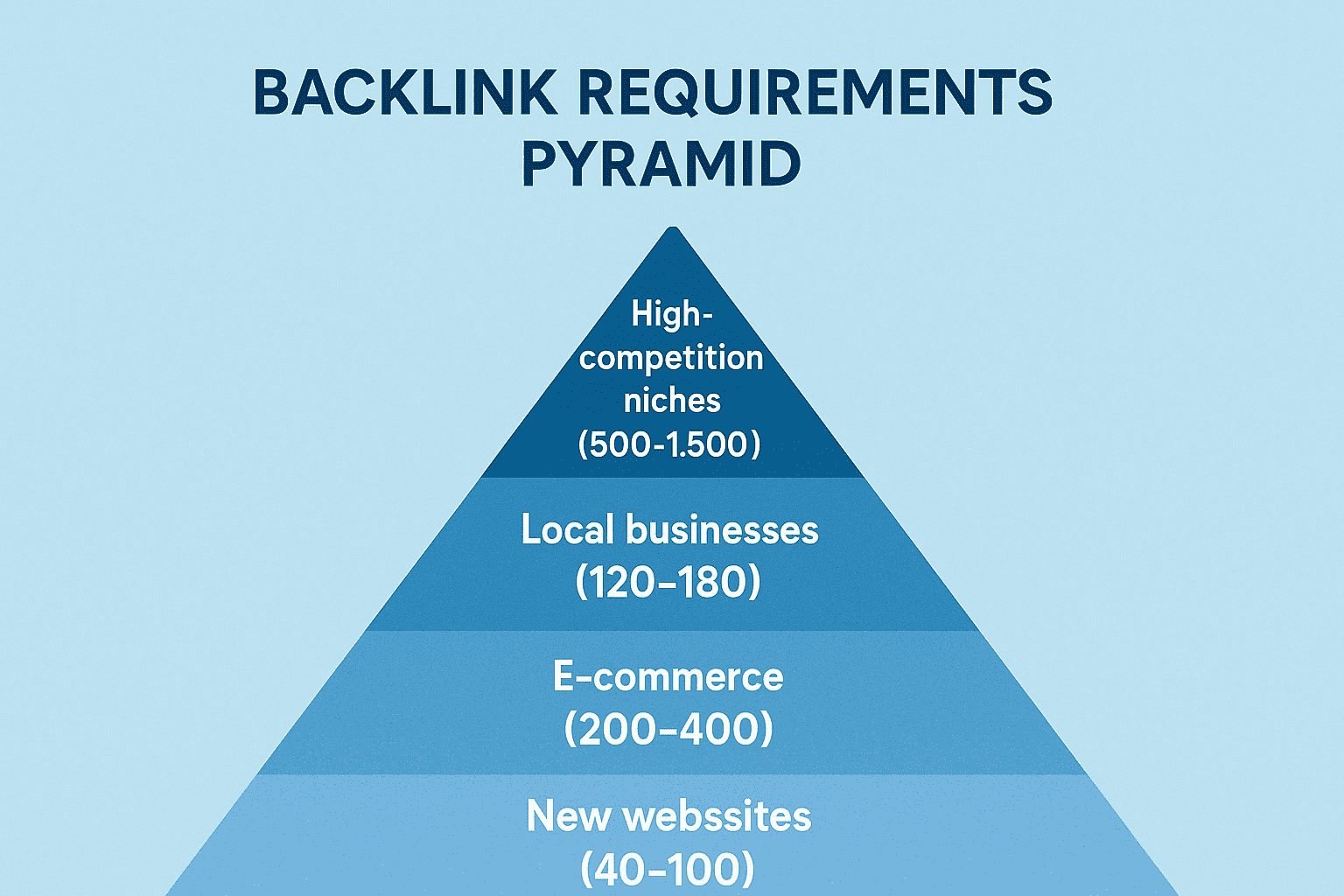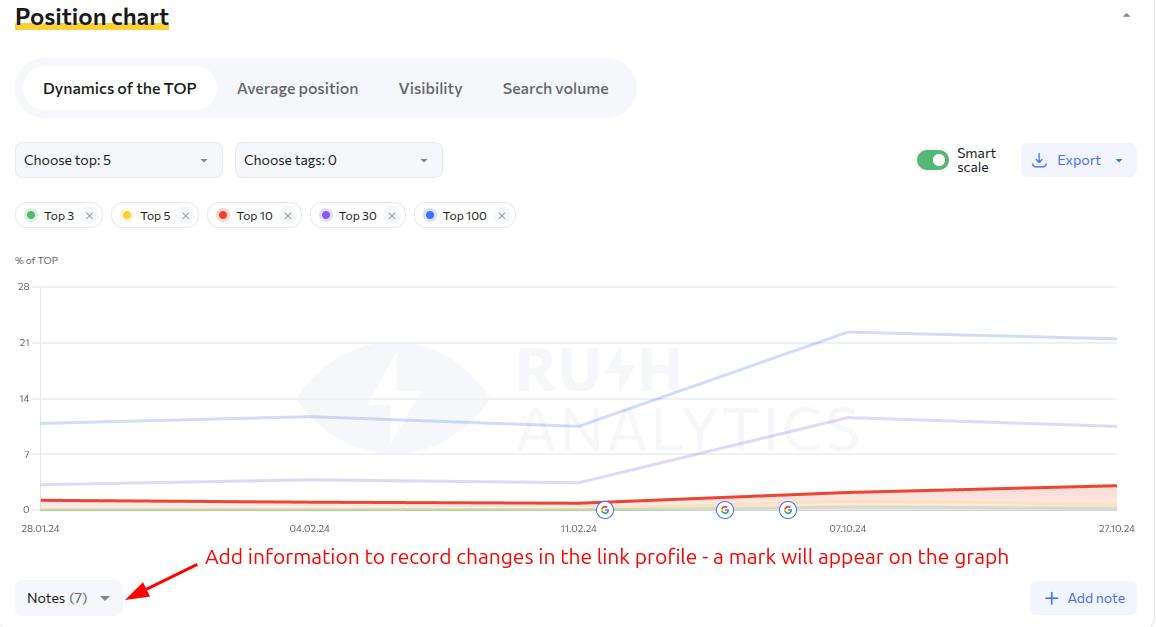You’re staring at your website’s analytics dashboard, watching your organic traffic flatline. Your content is great, your on-page SEO is solid, but you’re still stuck on page three of Google. Sound familiar? The missing piece of your SEO puzzle is likely backlinks – those crucial votes of confidence that search engines use to determine your site’s authority and ranking potential.
- Key Takeaways
- What Is a Backlink and Why Are They Important?
- How Many Backlinks Do You Actually Need?
- Track Your Rankings and Backlink Growth with Rush Analytics Rank Tracker
- Calculating Your Backlink Needs: 3-Step Process
- Factors That Determine Your Backlink Requirements
- What Makes a Quality Backlink?
- Backlink Strategy by Page Type
- Building a Natural Link Profile
- Safe Number of Backlinks to Build
- How to Check Your Current Backlinks
- Future of Backlinks in SEO
The frustrating truth is that 55% of websites have zero backlinks, while nearly 30% have too few backlinks to compete effectively. Meanwhile, your competitors are climbing the rankings with strategic link building campaigns. This guide reveals exactly how many backlinks you need to rank in Google, why quality trumps quantity, and how to calculate your specific requirements based on your industry and competition.
Key Takeaways
Every website needs different backlink quantities based on competition, industry, and target keywords. While most websites need around 40-50 quality backlinks to homepage and 0-100 to inner pages, quality always beats quantity. Focus on earning authoritative, relevant backlinks rather than chasing specific numbers. Strategic link building with more high quality links yields better results than accumulating low quality backlinks.
Building backlinks isn’t the only ranking factor, but it’s crucial for competitive keywords. Web crawlers evaluate not all links equally – one relevant link from authoritative websites can outperform dozens from irrelevant sources. Focus on fewer links of higher quality rather than as many links as possible from questionable sources.

What Is a Backlink and Why Are They Important?
A backlink is a link on an external website that points to a web page on your website, serving as a vote of confidence in Google’s eyes. Think of backlinks as digital recommendations – when other websites link to yours, they’re essentially vouching for your content’s quality and relevance.
Backlinks remain one of the top three ranking factors alongside high quality content and RankBrain. Here’s why they’re crucial for more organic traffic:
- Search rankings improvement: Google views links as endorsements, with quality backlinks from authoritative sites leading to higher positions in search engine results
- Increased organic traffic: Higher rankings naturally drive more targeted search traffic to your website pages
- Domain authority building: Quality backlinks build your site’s overall authority, creating a competitive advantage against other websites
- Referral traffic: Direct clicks from linking websites can bring valuable visitors even beyond SEO benefits
According to Google’s John Mueller, one relevant link can provide a stronger signal than many low-quality links. This emphasizes why website owners should focus on earning dofollow links from relevant websites rather than pursuing arbitrary numbers.
How Many Backlinks Do You Actually Need?
There’s no universal number of backlinks that guarantees rankings, as requirements vary dramatically by website type and competition level. However, research shows some general benchmarks you can use as starting points when building backlinks:
General baseline estimates:
- Homepage: 40-50 quality backlinks to start seeing results
- Inner pages: 0-100 backlinks depending on competition
- New websites: 40-100 total backlinks to establish initial authority
- Local businesses: 120-180 backlinks for local market dominance
- E-commerce sites: 200-400 backlinks across product and category pages
- High-competition niches: 500-1,500+ backlinks for competitive keywords
The exact number depends on three critical factors: your competition’s strength, your industry’s competitiveness, and your target keywords’ difficulty. What works for a local bakery won’t work for a national insurance company competing against established players with stronger backlink profiles.
Track Your Rankings and Backlink Growth with Rush Analytics Rank Tracker
To understand if your backlink building efforts are paying off, you need reliable tracking that connects your link acquisition with ranking improvements. You can’t manage what you don’t measure, and this principle applies directly to link building success.
Rush Analytics Rank Tracker helps you monitor your keyword rankings alongside backlink acquisition, allowing you to see direct correlations between new links and ranking improvements. The tool provides actionable insights to adjust your strategy, identify which backlinks are most effective, and determine if you need links needed for competitive keywords.
Key features for backlink strategy optimization:
- Daily ranking updates for up to 100,000 keywords across Google and other search engines
- Competitor comparison to identify link gaps
- Local and mobile ranking tracking
- Integration with Google Search Console for comprehensive data

Calculating Your Backlink Needs: 3-Step Process
Determining exactly how many backlinks you need requires a systematic approach rather than guesswork. This proven 3-step process helps you calculate your specific requirements based on real competitive data from websites ranking in your niche.
Step 1: Determine Which Pages Need Backlinks
Not every web page on your website deserves backlink investment. You need to focus your efforts strategically on pages that will drive business results rather than spreading resources thin across your entire site.
Prioritization criteria:
- Pages targeting keywords that generate leads and sales
- High-value service or product pages
- Content that naturally attracts links (comprehensive guides, studies, tools)
- Pages with existing traffic that could benefit from ranking improvements
Conduct a content audit using tools like Google Search Console to identify pages already ranking on pages 2-3 of search results. These pages have the highest potential for quick wins with strategic backlink building from relevant websites.

Step 2: Calculate the Backlink Gap
The backlink gap represents the difference between your current backlink profile and what you need to compete for top positions. This calculation gives you a concrete target rather than guessing how many links you need.
Analysis methodology:
- Use SEO tools like Ahrefs, SEMrush, or Moz to analyze top-ranking pages
- Note the average number of referring domains for positions 1-3
- Check the domain authority of linking websites
- Identify the types of content that attract the most links
For example, if the top 3 pages for your target keyword have 87, 92, and 73 referring domains respectively, you’ll need approximately 80-90 quality backlinks to be competitive. However, be aware that tool estimations can sometimes be misleading due to websites ranking with extremely high domain authority skewing the averages.

Step 3: Implement Your Backlink Strategy
Once you know your target number, implement a strategic plan to acquire quality backlinks gradually. You have two main approaches, and the best choice depends on your resources and timeline for building backlinks.
Option 1: DIY link building
- Analyze competitors’ best backlinks using backlink analysis tools
- Identify the methods they used (guest posting, broken link building, resource page inclusion)
- Find broken links on relevant websites using tools to find broken links
- Focus on building genuine relationships with industry websites
Option 2: Professional link building services
- Partner with reputable link building services for faster results
- Ensure they provide relevant, high-authority links from real websites
- Monitor quality and relevance of acquired links
- Maintain a natural link velocity to avoid penalties
Factors That Determine Your Backlink Requirements
Understanding the variables that influence your backlink needs helps you set realistic expectations and allocate resources effectively. These factors work together to determine your specific requirements for more high quality links.
| Factor | Impact on Backlink Needs | Description |
| Domain Authority | High | Higher authority sites need fewer links to rank |
| Keyword Competition | Very High | Competitive keywords require 10x more links |
| Content Quality | High | Outstanding content needs fewer backlinks |
| Industry Type | Medium | Some industries naturally link more than others |
| Internal Links | Medium | Strong internal linking reduces external link needs |
| Existing Backlinks | High | Current profile affects future requirements |
Domain authority impact: Your website’s existing authority dramatically affects how many new backlinks you need. High-authority sites (DR 60+) need fewer additional links to rank, while new sites require more links to establish credibility with search engines.
Keyword difficulty and competition: Tools like Ahrefs show keyword difficulty scores, but real competition analysis requires examining actual ranking pages. Low-competition keywords might need 5-10 quality backlinks, while competitive terms require 50-100+ links from authoritative sites.
Content quality and relevance: Outstanding high quality content that perfectly matches search intent requires fewer backlinks than mediocre content. Google rewards comprehensive, user-focused content with better rankings per link.
Industry and niche factors: Some industries naturally have more linking opportunities (tech, marketing) while others face challenges (medical, financial) due to stricter quality requirements from authoritative websites.
What Makes a Quality Backlink?
Quality dramatically outweighs quantity in modern link building, making it essential to understand what constitutes a valuable backlink. One high-quality link from authoritative websites can outperform dozens of low-quality ones from irrelevant sources.
Eight characteristics of quality backlinks:
- Thematic relevance: Links from websites in your industry or related niches
- Appropriate anchor text: Natural, varied anchor text that doesn’t over-optimize
- Real business sites: Links from legitimate websites, not link farms or PBNs
- Limited external links: Pages with fewer outbound links pass more authority
- Actual traffic: Linking sites should have real visitors and engagement
- Indexed pages: Links from pages that rank for relevant keywords
- Strong backlink profiles: Linking domains that consistently acquire quality links
- Editorial placement: Links placed within content naturally, not in footers or sidebars
According to Google’s guidelines, one relevant link from an authoritative source provides more value than multiple links from irrelevant sources. This principle should guide your entire strategy when building backlinks from relevant websites.
When conducting keyword research, remember that not all links are created equal. A few good backlinks from authoritative websites in your niche will always outperform hundreds of low-quality links from unrelated sources.
Backlink Strategy by Page Type
Different types of pages require different backlink strategies and quantities. Understanding these differences helps you allocate your link building budget effectively across your website pages.
Homepage backlinks (50-300+ depending on business size):
- Business directories and industry associations
- Press coverage and media mentions
- Partner websites and collaborations
- Local chamber of commerce (for local businesses)
- Professional certifications and awards
Resource pages (comprehensive guides, studies, tools):
- Naturally attract links through valuable content
- Should be content-rich with original research
- Include expert quotes and visual elements
- Update regularly to maintain freshness
- Promote through industry publications
Learn more about creating effective resource pages that naturally attract backlinks from other websites.
Money pages (product/service pages) (30-200+ depending on business size):
- Focus on hyper-relevant, industry-specific links
- Target review sites and comparison platforms
- Build relationships with industry influencers
- Secure mentions in relevant blog posts
- Avoid low-quality directory links
For e-commerce sites, consider specialized e-commerce link building tactics that work specifically for product pages.
Building a Natural Link Profile
Creating a natural-looking backlink profile protects you from Google penalties while maximizing your ranking potential. Artificial link patterns can trigger algorithmic or manual penalties, hurting your search engine results.
Anchor text distribution for natural profiles:
- Brand name and variations: 35-40%
- Naked URLs: 20-25%
- Generic phrases (“click here,” “learn more”): 20-25%
- Topical anchors: 15-20%
- Exact match keywords: 5-10% maximum
Safe link velocity guidelines:
- New websites (0-1 year): 3-5 new referring domains monthly for first 3 months, scaling to 8-12 by month 12
- Established sites (1-3 years): 10-15 new quality referring domains monthly
- Large sites: Can handle 20-50+ new links monthly if they’re high-quality and relevant
Sudden spikes in link acquisition can trigger red flags with web crawlers, so maintain consistent, gradual growth patterns that look natural to search engines and other search engines.

Safe Number of Backlinks to Build
There’s no universally “safe” number of backlinks to build daily or monthly, as it depends on your site’s size, industry, and existing backlink profile. The key is matching your link building pace to your industry’s norms rather than trying to get as many links as possible.
Industry benchmarks:
- Small local businesses: 1-2 quality links per week
- Growing e-commerce sites: 3-5 quality links per week
- Established businesses: 10-15 quality links per week
- Large enterprises: 20-50+ quality links per week
To determine your safe range, analyze successful competitors’ backlink growth patterns using tools like Ahrefs’ “Referring domains” report. Look for consistent growth patterns rather than sudden spikes that might indicate unnatural linking.
Red flag patterns to avoid:
- Acquiring 50+ backlinks overnight
- Getting multiple links from the same IP address
- Using identical anchor text repeatedly
- Building links only to your homepage while ignoring internal links
Remember, it’s better to have fewer links of higher quality than many low-quality links that could harm your rankings.
How to Check Your Current Backlinks
Before building new links, you need to understand your current backlink profile using reliable tools that provide accurate data about your existing links and their quality. This helps you identify opportunities for more high quality links.
Essential backlink analysis tools:
- Google Search Console: Free tool showing your top linking sites and most linked content
- Ahrefs: Comprehensive backlink data including referring domains, domain ratings, and new/lost links
- SEMrush: Backlink analytics with competitor comparison features
- Majestic: Detailed link metrics with Trust Flow and Citation Flow scores
Key metrics to monitor:
- Total referring domains (more important than total backlinks)
- Domain authority/rating of linking sites
- Anchor text distribution
- New vs. lost backlinks over time
- Toxic or low-quality links that need disavowing
Learn how to find backlinks of a website using Google and identify toxic backlinks that might be harming your rankings.
Regular backlink audits help you identify opportunities to strengthen your profile and remove harmful links that could hurt your rankings. Use the Rush Analytics Backlink Spam Checker to identify and disavow toxic links automatically.
Future of Backlinks in SEO
The link building landscape continues evolving with AI-powered analysis, changing user behaviors, and Google’s algorithm updates. Understanding these trends helps you future-proof your backlink strategy for long-term success.
Emerging trends shaping link building:
- AI-powered content analysis becoming standard for evaluating link quality
- Video backlinks gaining more weight in search algorithms
- User engagement signals increasingly influencing link value
- Brand mentions potentially becoming as important as actual links
- Social signals playing a larger role in link evaluation
Future-proofing strategies:
- Build strong brand presence across multiple channels
- Prioritize user experience and engagement metrics
- Create multi-format content (text, video, interactive)
- Establish genuine relationships with industry publications
- Maintain consistent quality standards across all content
Website owners should focus on building relationships with relevant websites rather than just acquiring links. This approach ensures long-term success as search engines continue to refine their algorithms.
Free 7 days access to all tools. No credit card required!
Попробовать бесплатно
Conclusion
The question of how many backlinks you need doesn’t have a universal answer, but following the systematic approach in this guide helps you calculate your specific requirements based on real competitive data. Focus on quality over quantity, targeting relevant, high-authority links rather than pursuing arbitrary numbers.
Remember that successful link building is about building relationships, creating valuable content, and earning links naturally over time. While tools and calculations provide direction, the fundamentals of creating linkable content and fostering industry relationships remain constant.
Start by analyzing your competition, calculating your backlink gap, and implementing a strategic plan that prioritizes sustainable growth. One high-quality, relevant backlink from an authoritative source can outperform dozens of low-quality links, making strategic approach more valuable than volume.
Use tools like the Rush Analytics SEO Audit to identify technical issues that might be limiting your backlink effectiveness, and track your progress with comprehensive search engine ranking tracking.
FAQs
How many backlinks do I need for a new website to start ranking?
New websites typically need 40-100 quality backlinks to establish initial authority and start ranking for moderately competitive keywords. Focus on building a foundation of relevant, authoritative links rather than rushing to hit specific numbers.What methods exist to determine how many incoming links my competitors have?
You can analyze competitor backlinks using tools like Ahrefs, SEMrush, or Moz. These tools show referring domains, total backlinks, and link quality metrics, helping you calculate the backlink gap for your target keywords.How many high-quality backlinks do I need for a local business website?
Local businesses typically need 120-180 quality backlinks to dominate their local market. Focus on local directories, chamber of commerce, industry associations, and local news coverage for the most effective results.Can having too many backlinks hurt my website’s rankings?
Yes, having too many low-quality or spammy backlinks can hurt your rankings. Google penalizes unnatural link patterns, so focus on earning relevant, high-quality links gradually rather than building large quantities of poor-quality links.






